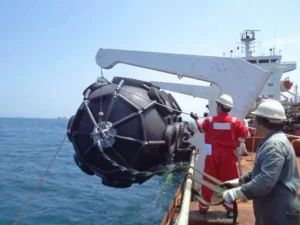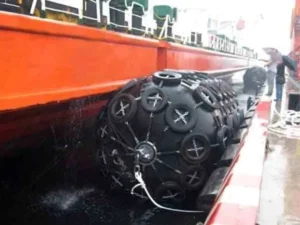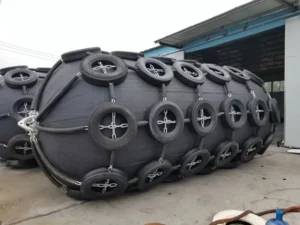Introduction
Rubber fenders do magic in the event of a collision. On one hand, they are protecting you from ship damage; on the other hand, they cause damage to themselves by absorbing all the collision energy. This phenomenon goes on until you turn out to be the savior.
Do you want to increase the longevity of a rubber fender? Great! We have listed why dock rubber fenders get damaged and help you maintain their durability for extended periods.
Why does even damage to your Yokohama rubber fenders occur?

First of all, think about the use of the boat’s rubber fender. It absorbs the colossal energy generated when berthing on the dock. Sometimes, ship-to-ship transfers are possible due to the fender rubbers.
In those cases, damage is imminent. Some events flare up in this scenario. These are as:
Friction Damage
Have you ever observed the ship docking events? Fiction damage is the primary occurrence when a ship has high speed and approaches the shore. The forward movement of the rubber fender and hull causes the corner dropping, abrasion, and severe damage to your rubber fenders.
Usually, this happens more in the D-shape and V-shape fenders that bring up more friction forces. You can predict this case in the mooring of the ship. The back-and-forth oscillations of the ship produce potent waves in the water. It leads to high pressure on the marine fenders, leading to quick damage.
Overloading
A cone rubber fender has some weak points. They are prone to injury during the ship berthing. D-type and V-shape fenders are the most famous examples of such damages.
When the ship is overloaded, Massive weight on board the vessel sometimes exceeds the capacity of the marine fenders. Whenever you have to berth the boat, considerable pressure strikes against the marine fenders, leading to linear cracks in the fenders. A high speed can fire up this situation as well.
Poor connections
Do you have the iron bolts and chains fixed to the marine fenders? Over time, iron results in losing its strength. When the corrosion of iron increases, it commences deterioration of the connections between the marine fenders and the boat.
The result is the weekend connections that are a tremendous problem when berthing the shipping. With massive pressure, they might be damaged. It also causes damage to the arch rubber fenders.
Adverse environment
When nature goes out of control, the damage erupts on your marine fenders. For instance, if you are in the middle of the sea, high-energy waves will strike your rubber fenders. If the energy exceeds the absorption limit of your marine fenders, it can be a big problem.
It can’t only damage your marine Fender but also your boats. In such a situation, you should avoid traveling across the sea.
How to find out whether your rubber fender is damaged?

Damage to marine fenders is occasional when you ignore the above reasons. If there is damage, you need to invest time in it.
It can be tricky to diagnose whether your marine fender is 100% excellent in condition and has some damage. For that reason, here are some checks you should consider D-fender rubber.
Initial inspection
Initial inspection is of the quality of the runner fender. Check whether you have pocketed a quality fender or just a crap one that doesn’t has a long life.
Initial inspections help check:
- Material quality.
- Any scratches
- Perfect installation
It is the best practice to give a trial test in marine berthing. It will detect the following problems.
- You have correctly installed your fenders.
- There are no loose connections.
- Vessel weight is not high for the given capacity of the marine fender.
Always go for the inspection before you come up with the use.
Daily inspection
Have you installed the marine fender? It is time to go for the daily inspection. It can be hectic, but in the initial phases of installation, you should do it.
Look for the following things.
- If there are any cracks
- Loosened nuts.
- Rust on the iron chains
Periodic inspection
Periodic inspection involves the comprehensive analysis of all the aspects. It is often a pre-planned inspection with determined parameters.
However, if you can’t make up with the daily inspection, periodic inspection is your deal. You can hire engineers to test the fender installation, material quality, and crack signs. Also, get tips regarding the loading and overloading of your ships.
Periodic inspection often repeats. For instance, if you have inspected on 8th Feb, you can try it out exactly after one month or whatever period you set.
Occasional inspection
Occasional inspection is quite different from the above types. Do you know why? Because you do it when there are apparent signs of cracks, rust, or dock rubber fender damage.
Sometimes, events like fire or harsh weather conditions might urge you to check the fenders. Like others, it is also a comprehensive analysis of your fenders and evaluates if there is any damage occurring or not.
How to avoid damage to the rubber fenders?

Damage to a rubber fender can be agony. You can prevent it by taking essential measures. These include:
Buying Quality Fenders
Why do you even sacrifice the quality of the fender for the cost? Stop doing that and buy a quality fender that has served you for decades.
Whether you buy a Yokohama rubber or a foam fender, look for the following features.
- What material does it have?
- How much pressure it can bear?
- It is compatible with your vessels.
- Does it have supplier’s warranties of years?
All these factors will minimize the pesky deal risks and get you a perfect marine fender which served for decades. Even a high pressure won’t cause damage to the fender.
Regular inspection
One of the best ways to evade pouring money into buying marine fenders is regular inspection. It will illuminate all the damages and define whether you need the following aspects.
- Removal. The part of the marine fender is of no use. You should remove it.
- Replacement. If there are signs of damage beyond repair, replacement is the million-dollar deal in such a situation
- Repair. If the rubber fender isn’t severely damaged and can be restored by correcting a component, that is better. In such a case, repair it instantly to avoid complete replacement or removal.
- Re-positioning. Some parts of the fenders are not properly joined. For example, holes are perfectly defined, causing problems in the adherence of fenders to vessels. Go for the re-positioning to dodge further issues.
Regular inspection keeps you safe from various situations and helps you get the optimal performance from the fenders.
Loading and Unloading
First, don’t overload your ships. They will rip off your marine fenders in case of high pressure. Second, be careful about the loading and unloading of the ships on the docks.
Here are some fundamental tips in this scenario.
- Whenever you are loading or unloading the boats, use an exemplary hoisting method. It must not put a strain on the marine fenders.
- Clean up your marine fenders before loading and after unloading your materials.
- Make sure cargo isn’t loose causing pressure on the marine fenders. Be sure of firmness of the goods in the boat.
- After your goods have arrived at the docks, unload them with a suitable material. Secure there is no damage to your marine fenders.
Monitor Storage
Inefficient storage areas with undesirable temperatures are a big problem for marine fenders. For example, the storage capacity must be 400 square meters. If you do not have that much area, it can be a concern.
Lack of accurate storage temperature is another significant cause for the lower efficiency of a rubber fender. Store is around -15° to -40°. Make sure it is away from all types of heat sources. At least one-meter distance is necessary. Plus, don’t expose it to the direct sunlight. Otherwise, it loses its original glamor. Also, remove any acids or alkalis in the storage. A single drop of acid can burn down your fenders.
Ensure corrosion-resistant materials
Whether you are using iron bolts or chains for the installation of the marine fenders to the boats, it can create hassles after years. Either paint the iron with some corrosion-resistant materials. If you can’t, replace it with a material that has similar strength but doesn’t get rusted.
That is how your Fender components will remain in optimal condition and support you whenever you berth the ships.
Conclusion
Maintenance of a rubber fender can be a hectic task for you. Why not buy a durable pneumatic rubber fender that needs less maintenance and offers the highest performance?
If you are searching for it, stop. JerryBorg Marine is a top supplier of different types of marine fenders. We believe only in quality and give you long-lasting solutions that have worked for years. Invite safety inside your doors with our Yokohama rubber fenders.
